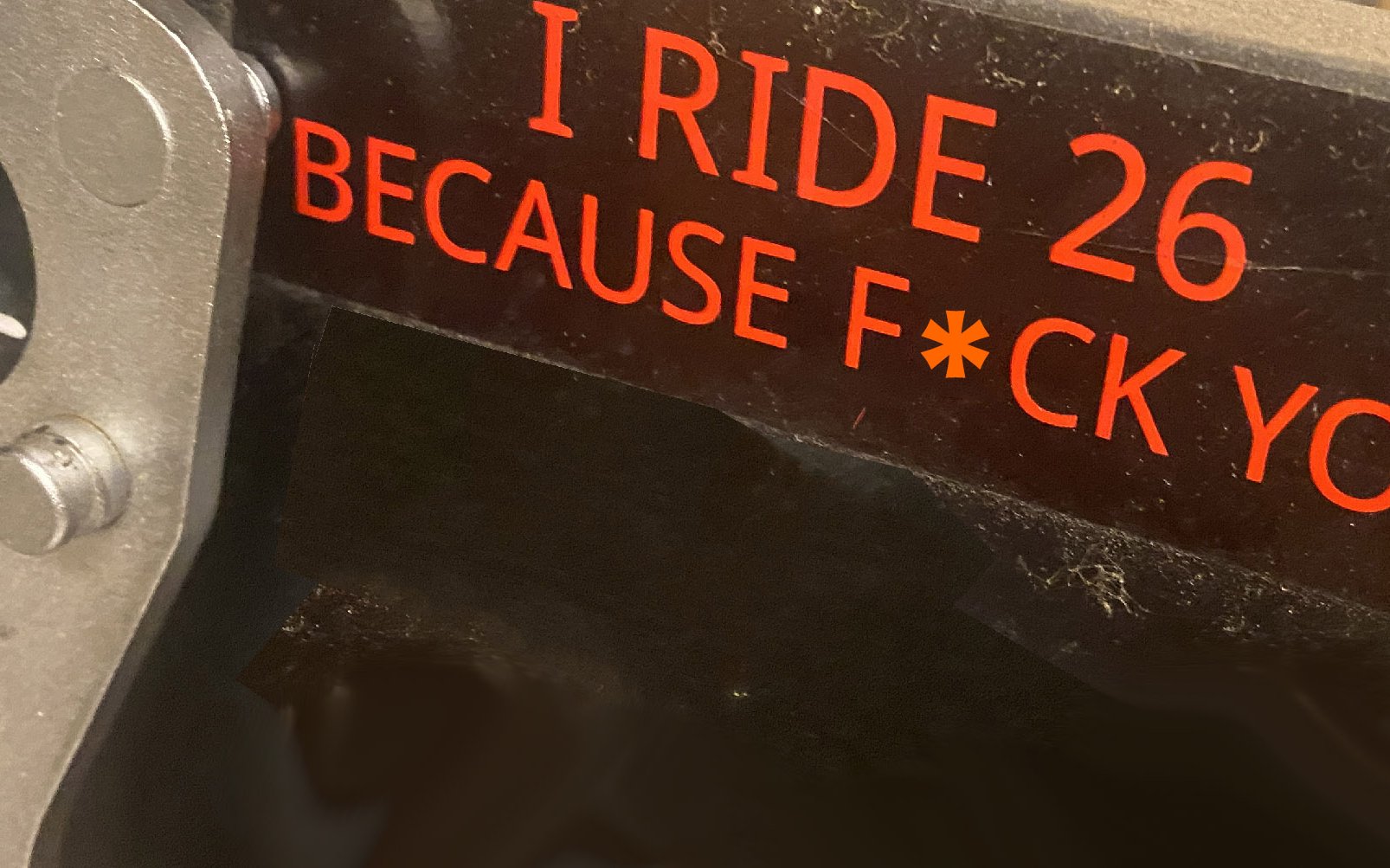
Editorial
Have We Finally Run Out of Wheel Sizes to Try?
If you have been a mountain biker since Hayes were the only disc brakes to buy, you know this tale: 26” wheels were fine for the first 30-odd years our sport existed. Little did we know nefarious characters were playing around with different diameters long before 29ers went into wide-scale production. And then in 2007 an interloper emerged in the form of 650b wheels for off road use when Kirk Pacenti commissioned some rims from Cane Creek and hand-sewed some tires to use on them. Despite these anomalies, aside from a few early 26” front with 24” rear mullets, like the Specialized Big Hit, hoop size was boring, and we liked it that way. Or we thought we did.
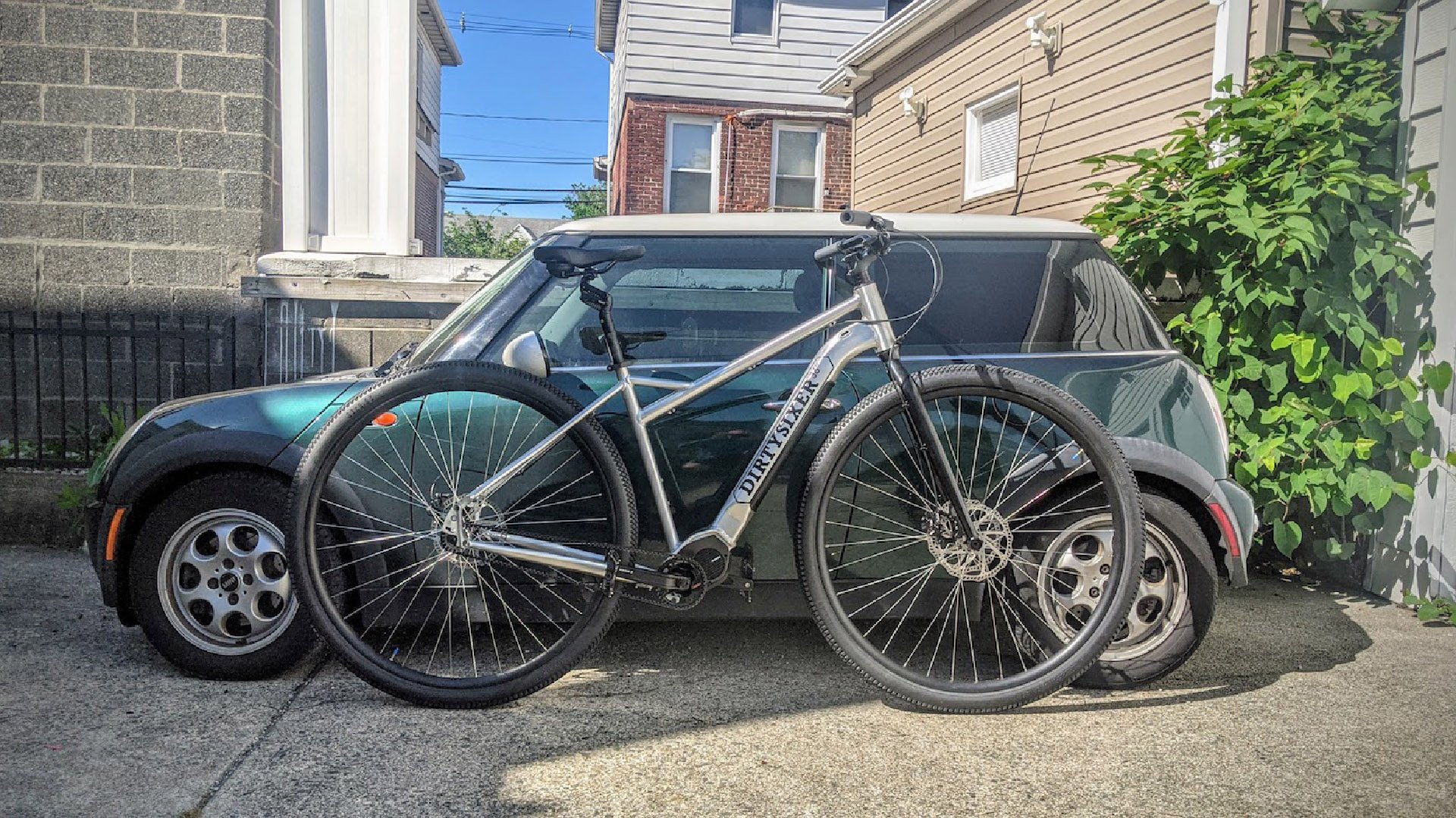
What's not to love? The world's largest eMTB.
Those new sizes had some supporters however. Riders who tried them appreciated the way 29” wheels stabilized your bike, rolled over obstacles easily, and seemed to even climb better despite the increased weight. Many early wagon-wheelers didn’t ride very well, as manufacturers tried to figure out how to wrestle the larger wheels into full suspension frames, and they often looked freakish, so there was an understandable backlash from riders who asked why 26” rims were no longer being considered circular.
The divide between big wheel lovers and haters followed a predictable pattern; in general, those into gravity disciplines hated 29ers while the lycra crowd tended to be early adopters who praised the larger diameter for endurance racing. This was a perfect storm for market turmoil, and it turns out turmoil is good for business.
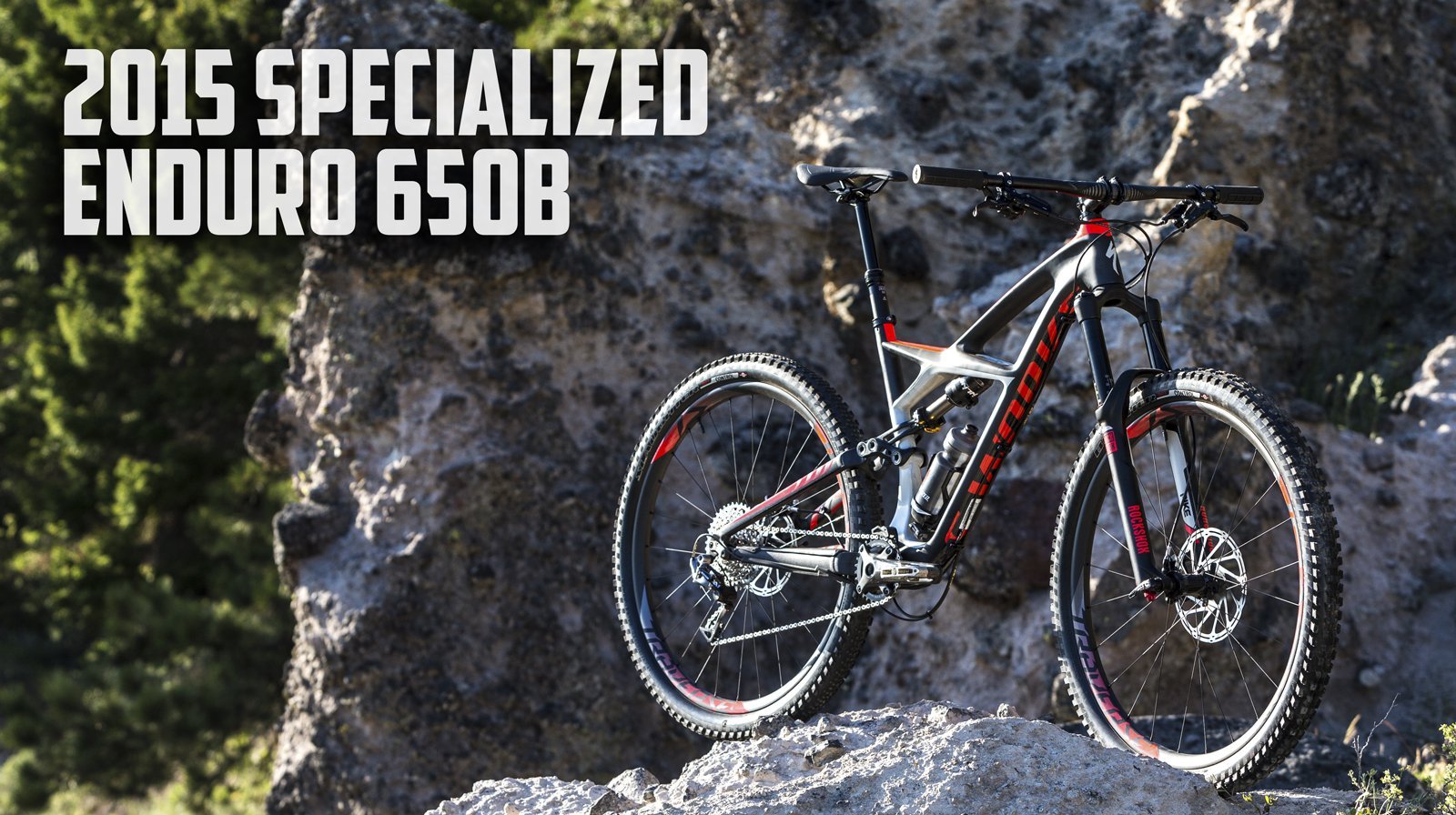
By 2015 Specialized was producing their Enduro model in 650b.
Several bike companies saw an opportunity to capitalise on the bubbling rage 29ers managed to stir in some circles, and they leaned heavily into what was then called 650b (and has come to be known as 27.5 and referred to as twenty-seven five - despite being closer to 27.0). Those companies did remarkably well initially because 650b bikes rode much like 26ers but were more stable, rolled better than 26ers, and were a little faster. The best of all worlds? For a time they were. Companies started making 29ers and 650b-ers, sometimes in identical models, while a few (like Specialized) stuck to 26 and 29 allowing Santa Cruz and others to take a bite out of their market share.
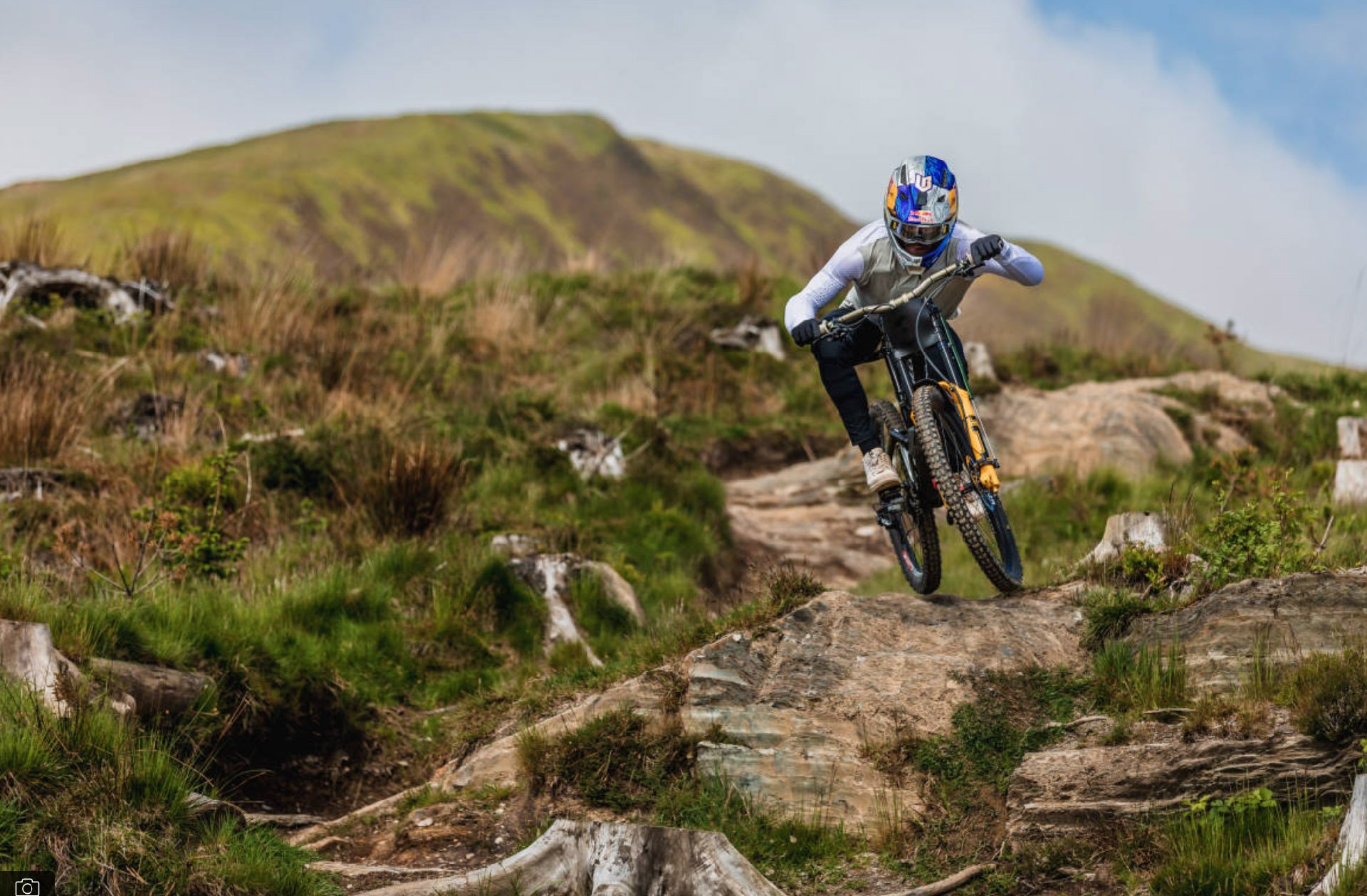
Downhillers were slow to adopt 29" wheels, (and when they did, the last and best claim of 29er haters was rendered invalid), but they dove into the mullet early. Loic Bruni at Dyfi Bike Park, Machynlleth, Wales 2022. Photo - Dan Griffiths / Red Bull Content Pool
Companies that rejected either 650b or 29 learned their lessons and before too long, the slightest whiff of a new wheel size had companies opening moulds and searching for rubber. Fat bikes looked to be the next big thing for what seemed like several years but was closer to five minutes. Market saturation for bouncy ball rubber took far less time than expected and just as full suss bikes with 26 x 4.0 or 650b x 5.0 tires started to be produced, they were mothballed, despite being ridiculously fun to ride in a wide variety of situations.
It was time for another tweener to emerge, this time in the form of Plus tires, that had some of the traction goodness of true fatties but with less weight and more control, despite tire selection being abysmal. Again there was a rush to market and a bunch of companies leaned in. Many models were made to be convertible between 29 and 27-plus for versatility, but Plus also died a hasty and fiery death. 29 Plus was a bit of a thing, but they never got very far despite enthusiasm in some circles for bikes like Trek’s Stache.
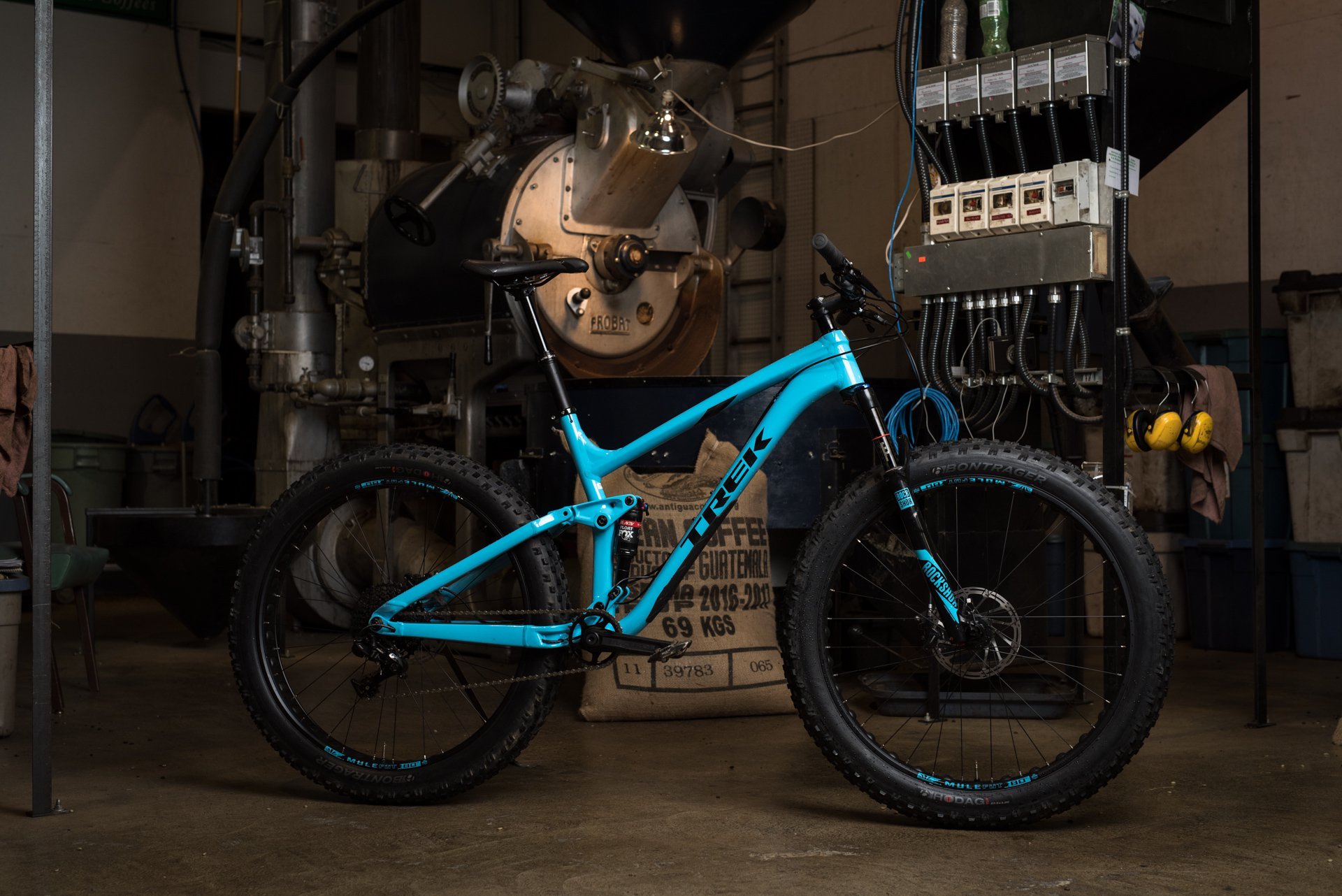
I'm a little sheepish about my affection for the Trek Farley fat bike duallie, but it was a stupid amount of fun on the trail.
This turmoil, along with changing standards (but let’s not get into that here) sold a surprising number of bikes because riders were afraid of getting stuck with an expensive bike they couldn’t sell, a fate many of us suffered. Companies can’t resist strategies that make them money and the confusion and turmoil got a bit out of hand, despite leading to some excellent progression and a new high water mark for performance bikes.
The current state of the mountain bike kingdom? 26” tires and rims are becoming difficult to source and some bike shops don’t even bother carrying them. As bike companies roll over new models, many have put 275 front and rear on the chopping block. Santa Cruz’s former 650b bikes continue to morph into mullets and while some companies, Canyon being one example, produce models that include options of 275 front and rear, mullet bikes with 29 front and 275 rear, and straight 29ers. Despite this, the cancellation of bikes with 275 wheels exclusively seems well under way. Which leaves us where we are now; with mullets for some applications, like DH and enduro, 29ers for all kinds of bikes that aren’t flipping or spinning, 275 for riders who aren’t large enough to comfortably ride 29ers, and 26ers live on for dirt jumpers, slope riders, and proud and stubborn luddites who are perfectly happy with their tiny little wheels, despite being banished to rubber Siberia.
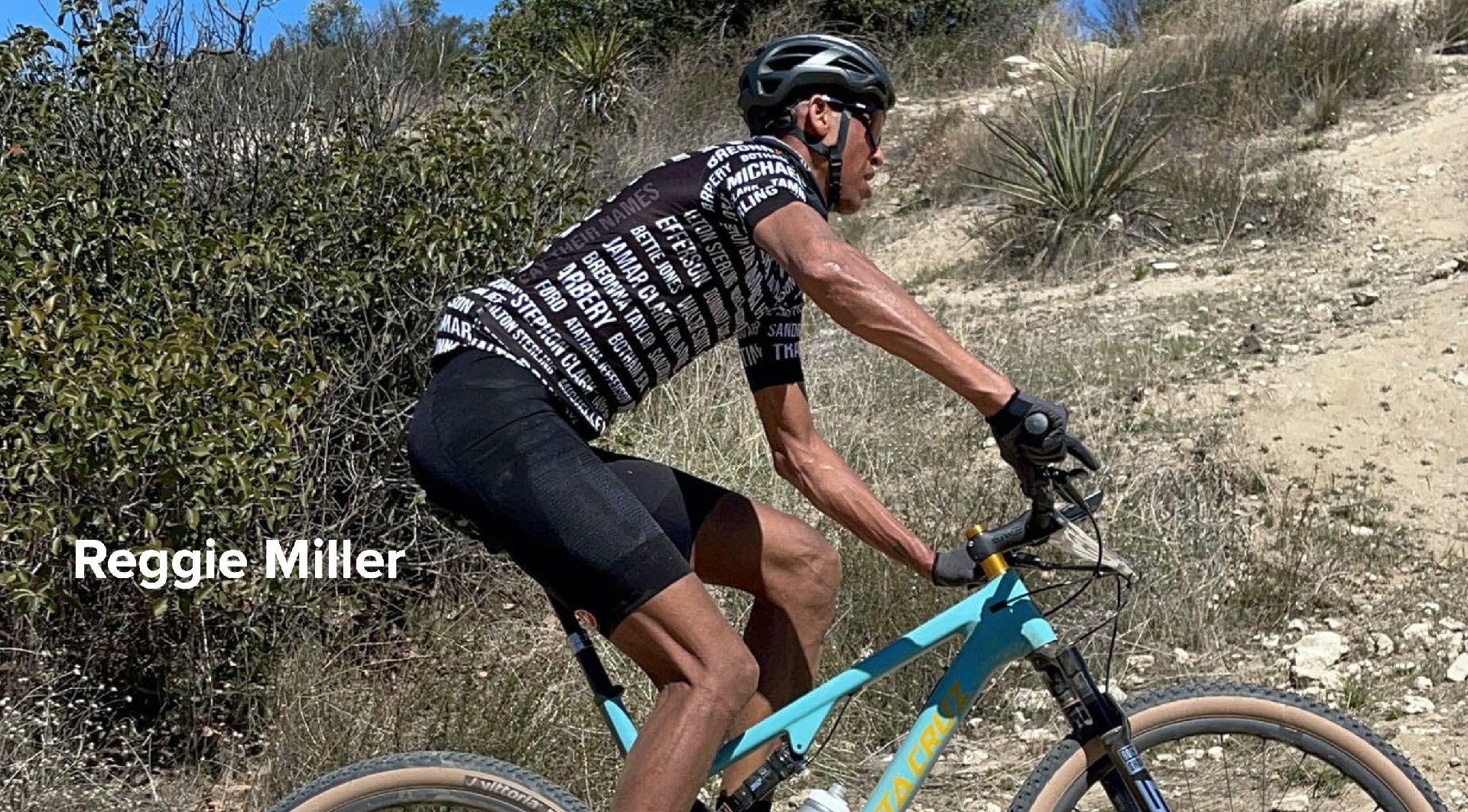
Reggie Miller needs more performance than a full-rigid Dirty Sixer can provide so he also rides and races an XXL Santa Cruz Blur
Is it time to breathe a big sigh of relief? This feels like the most stable scenario in terms of wheel circumference since before Kirk Pacenti pulled out a needle and thread. Tires for big wheels are available in virtually any compound, sidewall, and tread pattern there is, and while they don’t provide the same mesmerizing sensations of some smaller-wheeled beasts, and are harder to tip into corners (a trait mullets excel at), they are undeniably fun and capable to ride.
I'm not saying the bike biz mafia Dons and Wiseguys hashed out this plan at their annual sitdown at Davos;* they just painted themselves into a corner by already trying everything they could imagine. Or maybe this is premature? Is there a reverse mullet mule being welded up by the crankiest employees at Giant, Trek, and Specialized? You may have heard that Travis Brown, founding father of the 29 and 26-combo, the 69er, has spent some time on both 32 and 36" wheels, and that basketball legends Shaq and Reggie Miller* both own bikes from the custom builder Dirty Sixer, which rhymes with a size of wheel, but I can't imagine any scenario where the wheels on the bikes we ride for aggressive terrain get larger. This feels like when you were 16 and you looked at a cool car and thought to yourself, "nothing will ever be cooler," but the next year there were several dozen models that you liked even more. It's a never ending cycle. Except when it isn't.
**Reggie also rides bikes for mortals like an XXL Santa Cruz Blur
* Actually below Davos Get Smart style
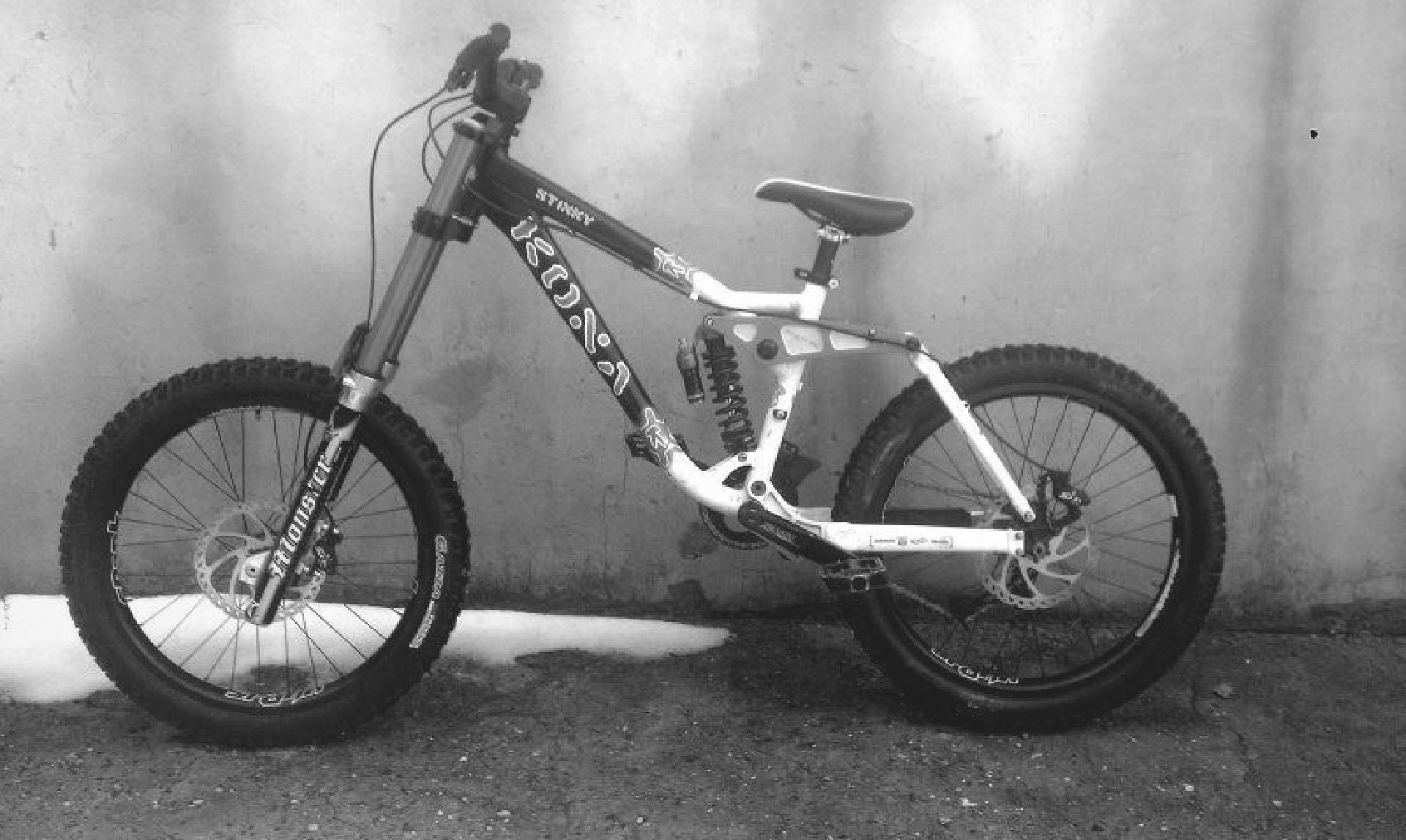
I think the first bike I saw on the Shore with funny wheels had dual 24s with Gazzoloddi 24 x 3.0 tires - which looked enormous at the time.
I talked to our resident motorcycle historian, Mike Ferrentino, about off-road moto wheel size over the years, and he had much to tell me. The take-home was, there were a few detours along the way, like the Yamaha DT1 with 19" front and 18" rear, motorcycle wheel sizes for dirt have been stable at 21" front and 18" rear for most unpaved applications, and 21" front and 19" rear for motocross, mostly since the 70s and entirely since 1983. In fact off-road bikes pretty much use the same suspension system as well. That sounds pretty homogenous but then you realize how much development energy is left to produce better tires, suspension, drivetrains and brakes. Even better, there's a chance your wheels from last year might fit next year's bike.*
*Maybe a little far-fetched
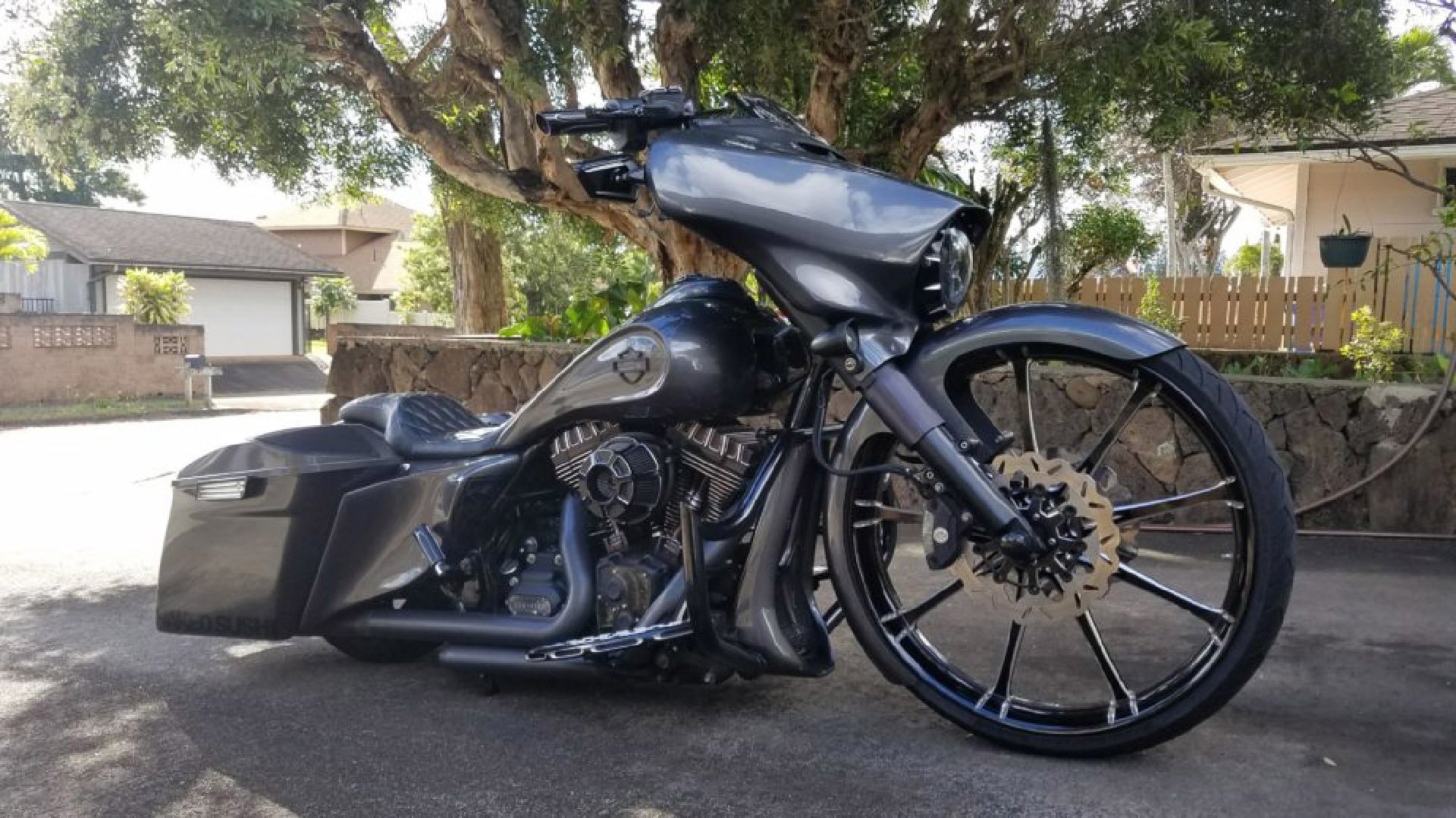
Why can't bikes be like motorcycles, with wheels that are all the same…
Before I declare this case closed, far be it from me to underestimate the bike industry’s ability to squeeze something shiny and new out of what was shiny and new last year. And I don’t say that entirely cynically. This reluctance to rest on laurels has created some great innovations, and some complete flops, but there are several expressions, now cringeworthy from overuse, that prove this is the best way forward in life. I'll choose the Canadian version, attributed to Wayne Gretzky: “you miss 100% of the shots you don’t take.” And you have to admit, the current crop of performance bikes, while more costly than you could have ever imagined, rides incredibly well.
I'm probably being irrational and overly optimistic, but in the immortal words of Mr Burns, "shoot for the stars, you might hit the moon."



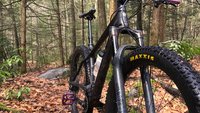







Comments
Littleman
1 year, 9 months ago
Interesting article. I’m in the “not large enough to comfortably ride 29ers” camp. Or at least I think I am. I’m a 5ft (0”) (152.5 cm) dude, who’s been riding since the mid-nineties, and like techy, steep, challenging trails. I bought a 27.5 (Transition Scout v2) even though I knew at the time that the “industry” seemed to heading towards 29ers. I just felt 29ers were too big for my short arse (especially with short legs / long torso). My wife has a 29er (Smuggler), and I have tried it and love it on mellower UK trailcentre type stuff but I just feel that a) the back wheel buzz would be too much for me on my preferred steeper / more natural terrain, and b) that I can't get my bars low enough with a 29er front wheel with any decent amount of suspension travel.
As the writing seems to the on the wall for full 27.5 ers, I keep on thinking I may be forced into riding a bike that isn’t a good fit for me, even with a mullet. I could mullet the Scout, the 20mm difference in front/rear suspension travel (150mm/130mm) means I could put a 130mm 29er fork in and the geo wouldn’t be that wildly different/kooky, but I keep on coming back to my bar height. My (lowish rise) bars are already currently as low as they can go (with a -1deg Works Components headset in) – whenever I’ve tried them higher I keep on lowering them back again. I know Seb Stott has written in the past that he feels bar height is critical and that shorter people may be better with a full 27.5 to get the bars at an appropriate height. One person’s opinion of course but I have genuinely tried riding with a higher bar and I just can’t get my weight over the front for front wheel grip in corners.
Then I think, if Isabeau Courdurier who’s also small can ride an enduro bike with a 29” front wheel, why the hell can’t I. Then I think some more, hang on she’s a super fast pro and I’m a man in his 40’s trying to ride his bike as often as he can in between the usual life stuff, so my riding ability bears zero resemblance to hers therefore what Isabeau does is probably irrelevant to me.
I’m not sure where I’m going with this ramble, other than I hope that full 27.5 bikes don’t die off, however it does seem inevitable. I guess In future I’ll be forced into having a 29er front wheel at least, assuming mullets stick around. I don’t change bikes often so the Scout will last a good few years yet but it will be interesting to see when new bike time does arrive, what will be available to me. I know I’m an outlier size wise though so I’ll always be on the periphery for bike brands.
Reply
fartymarty
1 year, 9 months ago
Mullet with a 275 front wheel and 20mm more travel up front???
Strangely I see a resurgence of 275 bikes as people get "bored" of very capable big bikes.
Reply
Littleman
1 year, 9 months ago
Yeah I guess so, but that’s still an extra 20mm on the bar height isn’t it? Same issue.
Reply
fartymarty
1 year, 9 months ago
Angleset and matching front and rear travel could do the trick.
One positive is that geo is now fairly sorted and a newish bike is still going to have similar geo in a few years.
Reply
Cr4w
1 year, 9 months ago
I do not understand the move to end dual 27.5. There are plenty of legit use cases. It's pretty clear a lot of people shouldn't be on dual 29 or even 29/27 mullets. There are smaller people out there for whom dual 27.5 makes perfect sense. It's weird to watch a tiny person on a long-ass dual 29er and they can't get enough leverage on the bike to make it do anything. But you can just hear the guy in the store telling them how great dual 29 is the just the thing for everybody, that it's faster and rolls over things better and that no one should ride a bar less than 810mm wide. Because in mountain biking we are always pushing the same story for everyone.
Reply
SilentG
1 year, 9 months ago
Until a new story comes along and that is the go to move, never mind this other thing, it is for suckers, you need the real for real this time (nudge nudge, wink wink).
I was fine with 26" and I'm on 27.5" currently and if other people like something else more power to them.
Thinking out loud here...29" isn't the last chapter in this story, no way, the temptation is too great to move to something betterer and then everyone is *encouraged* to march in lockstep to the new (we double pinkie swear this time!) best thing ever...ignore those folks over there, they are freethinkers or the unwashed who do not partake of the holy kool-aid (and you know this glass is the most tastiest one ever, right...right?...RIGHT!!!)
But I digress...what were we talking about?
Reply
Cam McRae
1 year, 9 months ago
Well said SilentG!
Reply
Tjaard Breeuwer
1 year, 9 months ago
As a bike fitter, I couldn’t agree more.
Yes, 29ers might have a touch more roll over capability’s, but with high trail, long front center geometry, and big tires, possibly with inserts, it’s not like 27.5 wheels are really struggling in that department.
On the other hand, too big of a reach and stack have a huge negative effect on bike handling, and thereby the ability to roll (ride) over stuff.
It is simply not possible to have a long travel fork and big wheels, while still keeping stack low.
I do think there is room for 2 wheel sizes. Yes, it creates more sku’s and potential replacement options, but I think that is worth it for the different fit options as well as the different feel/characteristics they create.
Reply
Cr4w
1 year, 9 months ago
Two sizes already exist. It's not like anyone is advocating to add more and all that comes with it. All the SKUs and forks and tires and inserts already come in 27.5.
Reply
taprider
1 year, 9 months ago
for XC and Downcountry, many new forks and tires are 29"only
Reply
danithemechanic
1 year, 9 months ago
I didn't read anything, actually i just turned the computer on after a 3 day trip, but I NEED THAT STICKER.
Reply
nothingfuture
1 year, 9 months ago
I think we need to accept that there are more than one "good" wheel size- and that it depends on rider size, weight, goals, terrain, and suspension. Anybody trying to tell a different story there is selling you something.
Reply
fartymarty
1 year, 9 months ago
Wise words
Reply
Mike Ferrentino
1 year, 9 months ago
I don't think there's going to be any broad push toward a new wheel size anytime soon. The wheel sizes that define the entirety of mountain biking are all rim diameters that already existed. It's as if, when it comes to wheels, mountain biking doesn't really do new. The 26" standard that embodied the first three decades of mountain biking was lifted from pre-WW2 Schwinn cruisers, and I suspect the only reason Ignaz settled on those for his "paperboy" bikes was because he got a sweet deal on a raft of leftover German scooter parts sometime before the depression hit. Mountain bikers had the good fortune of being just barely preceded by BMX and the lucid foresight of that sport to include a 26" cruiser class for the geezer dads who wanted to race but didn't want to get killed by their own slow reflexes on 20" bikes, so we had an available market of alloy 26" rims to draw from.
29"? Exact same bead seat diameter as every bike in the TourDayFrance for the past, ummm, hundred or so years, maybe longer. Once upon a time there were also 700a, 700b and 700d rims that were all slightly different in diameter, but 700c became the defacto standard for road cycling, and therefore was a super easy adaptation into the 29er.
Same with 27.5, or 650b as it used to be known. Been around forever, got a new life thanks to Kirk Pacenti.
So, if we follow the pattern that has defined mountain biking since it began, the only new wheel sizes we can expect to see will involve either 630mm bead seats (a whopping 8mm jump in diameter over 700c) scavenged from old 27" road bikes or else a rousing new wave of gigantic wooden rims as we explore the Ordinary route. I better stock up on mustache wax, just in case...
Reply
ShawMac
1 year, 9 months ago
Penny farthings are starting to make a comeback if we are going to scavenge from various existing wheel sizes.
The mullet extreme
Reply
cheapondirt
1 year, 9 months ago
Options are the best. What you and I want out of our bikes is going to vary.
I don't really give a crap how fast I go, but enjoy the sensation of speed. I like small wheels and short rear centres. You can keep your rollover and balanced weight distribution: I just want to play. I can easily fit a 29er, but I'm glad I don't have to.
This spring I went from a 26+ rear wheel (in a 650b frame) to 650b. I don't like how it made the back end feel longer, the diameter difference is surprisingly tangible. I can live with it for the higher speeds of summer. The 26" wheel is likely to stick around for winter duty.
And that's about all I need to experience to know that a 29" rear wheel isn't for me, at least not right now. I reserve the right to change my mind! Mullets do appeal a bit more.
Reply
[email protected]
1 year, 9 months ago
I put 26 wheels on a new 27.5 frame I bought this year because F*CK YOU
I was worried it would be weird/bb would be too low. It's all good.
If you are short (like me) 26 still makes sense.
Schwalbe tyres, rimpact inserts....it's all up to date other than the wheel size
Reply
cheapondirt
1 year, 9 months ago
I'd like to hear more about your 26er! Did you overfork it or do anything else to compensate?
Reply
[email protected]
1 year, 9 months ago
It has 2017 27.5 160mm yaris on it.
So as a 27.5 designed frame with 160mm rear travel it was only the bb height that i saw as a risk ...but it has a relatively small bb drop so it's all good so far.
I was basically updating a frame to a 26er set up I had on 2013 kona process 151 and figured I'd use the wheels I had.
You wouldn't spot anything giving it away as 26 unless you clocked the period mavic 721 rims
Reply
cheapondirt
1 year, 9 months ago
That's cool, thanks for sharing.
I built up my '18 Altitude with 26x2.8 Minions when I first got it. It was pretty low but the 26er fork didn't help. One could get away with it using a 27.5 170mm fork and Ride-9 chip in the highest position.
Reply
Timer
1 year, 9 months ago
There is a very practical case against 32" and particularly 36" wheels. Such a wheelsize, combined with the current long frames, wouldn't be compatible with existing bike infrastructure.
They wouldn't fit on current bike racks (both vertical and horizontal), and even if they make ones that fit, the overhang would not be road legal in many countries.
They also wouldn't fit on many bikepark lifts and shuttle trailers. This can already be a problem today with 29" and XXL frames.
Reply
cxfahrer
1 year, 9 months ago
Haha true, my XXL 29 if hung with the front wheel from the chairlift hits the ground.
And even my XL hardtail with a modest 1250mm wheelbase was too long to be put safely on the rack, some roads and highways left lanes here are only 2m wide. Had some embarrassing moments when the driver of the VW bus didn't remind that when overtaking or driving into the parking.
I am the exact same size and weight (and just a little bit older) as Mr. Miller and can't think of anything bigger as 29" in the rear, but maybe a bigger front wheel? But that would require a choice of longer forks, and until that happens I am too old riding.
Infrastructure won't matter, this will adapt. E.g. horses are much more popular than ponys.
Reply
Cr4w
1 year, 9 months ago
My XL G1 (1355mm wheelbase) barely works in a NSR4 hanging rack. I have to be careful on some driveways not to drag the bike on the ground; I've hit the rear wheel hard enough to bounce the bike out of the cradle. Off-roading and waterbars? 100% no (but I'm haven't done that in years). Even on regular trails you get a distinct feeling that the trails were cut for a very different bike. It's totally doable and worth it for me to get good riding ergonomics and feeling properly centered on the bike. As much as I'm intrigued by even bigger wheels sizes I think with 29 and progressive geometry we're pretty close to the edge of what most trails are designed for.
But a 32" wheeled gravel bike? Sign me up. And despite having no interest in 36 though TBH I've never ridden one so never say never I suppose.
Reply
Morgan Heater
1 year, 9 months ago
I bought a piece of square tubing 4" longer than the top upright on my north shore rack to keep all the long bikes from dragging or hitting bumps.
Reply
Velocipedestrian
1 year, 9 months ago
My mullet hardtail with its 1230mm wheelbase is already at the limit of the racks on our city busses. Any longer and I'm not getting that cheeky cheap vert assist.
Reply
danithemechanic
1 year, 9 months ago
Ok i've read the article.
Wheel size preference debate aside, through almost ten years as a bike mechanic i developed this theory, were the industry actually leans to standardize one wheel size for all just to be able to produce less variations of the same thing, thus supporting more the newest bikes sold.
Now let's picture this: between all the bikes produced every year in the world, wich percent of mtbs requiring high end tires there are?
I think that, no matter how big us enthusiasts think gravity riding is (i'm generalizing), it makes a really small percent of the worldwide biking market. Though a small percent with a big gain potential.
My idea is, that instead of supporting older models like the automotive and motorcycle industries do, there's a a general idea of dropping the support of the older technologies because selling a new bike is considered more profitable.
Sincerely i think that in these hard times for production and environment this is the biggest mistake our industry can do, and i wish wheel sizes, all of them, would be considered just an option.
P.S. : Cam, i still need that sticker.
Reply
Cam McRae
1 year, 9 months ago
The sticker was a present from Seb Kemp. If you can still get one, I’d ask the googles. Sorry I can’t be of more help.
Reply
danithemechanic
1 year, 9 months ago
Thanks man!
it's funny that the sticker comes from the Global Brand Director of Santa Cruz.
No worries, i can repro it, make it up, tattoo it ...
Reply
Cam McRae
1 year, 9 months ago
I can't remember if he was already at SC then, but it was certainly before he was wearing that big sombrero.
Reply
fartymarty
1 year, 9 months ago
Cam - Very timely, I've been on the big hoops for nearly 8 years now (3 on FS and 8 on HT) and they are great and all.... But I was wondering could I be having more fun on 275 HT. Yeah it's not going to be quick but I still have a 29FS if I want to ride at mach-chicken. It's not going to be as smooth as a 29HT but HTs aren't smooth anyway... As long as the geo is sorted I can still ride the same trails.
Maybe the right tool for the job (big hoops and FS) is too safe and boring?
Reply
Cam McRae
1 year, 9 months ago
Here here!
One of my favourite bikes in recent memory was the full 27 Santa Cruz Bronson I rode in 2018 or so. I loved that bike and it did everything I wanted it to. Have fun, and ride what you want for as long as you can practically? Makes sense to me.
Reply
Todd Hellinga
1 year, 9 months ago
into season 4 on my gen 3 bronson, still loving it and have a hard time thinking I need to upgrade at this point, especially given the marginal gains and price points.
Reply
Pete Roggeman
1 year, 9 months ago
Plus we know you're holding out for an e-bike...
Reply
Todd Hellinga
1 year, 9 months ago
uh, yeah, that's it!
Reply
Jerry Willows
1 year, 9 months ago
32" will come to the XC world for sure...
Reply
Kenny
1 year, 9 months ago
When I ride my 275 bike for a while then switch to the 29er, I always think this.
In terms of covering rough terrain quickly and efficiently there's just not comparison, I'm shocked there's not a bigger push to try to take it a step further.
Reply
Suns_PSD
1 year, 9 months ago
Some timed testing shows that for at least some, it's just a feeling with little to no speed differential. GMBN did a mullet vs. full 29er test using a 5' female rider (I think) and a nearly 6'4" rider.
The petite rider preferred and was faster on the Mullet, the big guy was 2 seconds slower on the mullet but also had more fun and for his big bike was going to swap to Mullet, for the fun factor.
Both riders felt the smoothing action of the 29ers.
Riders have definitely heard the siren song of 29ers. A 5'1" woman came to look at my my wife's size S high end 650b bike, then realizing it was a 27.5" scoffed and said 'no thanks, I thought it was a 29er'.
My general opinion for trail/ AM riding is smaller adults should run 27.5s, medium adults mullets, and larger adults straight 29ers.
Reply
silverbansheebike
1 year, 9 months ago
As someone who still rides 26" proudly (though only a luddite when it's for humors sake), I bought my frame knowing the dropouts could be swapped for a larger wheel size when I eventually get pushed out of 26", and given the limited 27.5" forks on the used market at the time, I knew I would one day need a new fork. Amazingly, I still have no trouble getting my choice of tire in 26", and so for me I really just cant justify new for the sake of new, or different for the sake of different, at the cost of 2 rims, tires, tubes, and a fork.
Reply
Allen Lloyd
1 year, 9 months ago
I remember pointing and laughing at 29'ers when they came out. Then a few years later I rode one and instantly felt more comfortable on a fully rigid bike than I did on my full suspension bike. Now that geometry has worked out how to do full suspension 29'ers right that is my preference. My wife has a 27.5 bike and it just feels funny to me. My 29'er is plenty playful and the idea that wheel size drives fun is crazy. Geo makes a much bigger difference.
All that said, I learned long ago that it is much better to have options available than to be limited. I hope companies continue to offer different options for people who like different stuff.
Reply
Cam McRae
1 year, 9 months ago
An often overlooked factor about the fact that 29ers roll over obstacles well, is that they don’t generate as much force when you are working the backside of a roller.* I agree with you about geo, but if the geo is good on both bikes, the smaller-wheeled bike will be lighter and more manoeuvrable. It will also turn in more responsively and you’ll be able to tip it over further.
As with most things, there are trade offs involved when wheel size goes up.
*credit for this observation goes to Chris Porter
Reply
mrbrett
1 year, 9 months ago
So 29” doesn’t pump as effectively? Interesting. I’ve never even thought about that before … my mind is pretty blown.
Reply
Tjaard Breeuwer
1 year, 9 months ago
Yep, and nothing pumps like a 20” (BMX) wheel
Reply
Cr4w
1 year, 9 months ago
I remember a day on a Whistler west side trail on my first modern 29er (2012 Enduro 29 alloy) and it handled steeps-to-g-out so much better than my ill-fitting 26" Demo. I put the Demo up for sale the next day. What good is that slack head angle and big fork and shite pedalability if if can't get me down gnarly steeps? I think a lot of people had that realization. And that capability only improved along with 29er geometry and the modern progressive era.
Reply
Pete Roggeman
1 year, 9 months ago
Cam, I think I can wrap my head around this idea, and I have no reason to disbelieve Porter* but I'd love to read about that if you can remember where you saw it (heard it?). Also I wonder if the larger wheel's ability to carry speed better somewhat offsets a smaller wheel's ability to accelerate better when being pumped? Deeply nerdy but interesting.
*you're a different story
Reply
Cam McRae
1 year, 9 months ago
Luckily I remember where I heard it or read it. ‘Twas on the internet.
The context was that early 29ers were shite but I don’t recall much else.
Reply
Allen Lloyd
1 year, 9 months ago
I don't know the physics, but it makes sense that a smaller wheel can pump a roller more. A matchbox car will gain more relative momentum rolling down a ramp that a full sized car rolling down the same ramp.
My argument would be that it is all feature size dependent. The bigger the roller the smaller the advantage, so your local trails could dictate how much advantage is created.
Weight is an odd one for me, being a larger (200 pound) dude I generate a ton more momentum down a slope than lighter people. Bike weight as a component of total bike and rider combo is very small. Rotational weight differences are fairly small as a % of the total as well. You can run a carbon 29'er wheelset that is lighter than and al 27.5 setup. But your cassette plays a bigger role than wheel size.
Turn in and maneuverability gains in geo have made a bigger difference than wheel size. I know you are saying same geo the smaller wheel is better, but compared to a 10 year old bike the geo is what makes the biggest difference in this area. I would argue that modern geo evolved to make a 29'er feel more like a smaller wheeled bike in many ways.
At a very high level the larger wheel is acting like a longer lever. Like you said there are tradeoffs based on wheel size. I would love for an engineer to do some work on what is actually happening force wise with larger and mixed wheel sizes. Too much of this stuff is feel and a combination of 1,000,000 other factors, making it hard to really understand what the different sizes actually do.
Reply
LWK
1 year, 9 months ago
I have a Remedy and a Stache. This is absolutely my experience as well. Its not that I cant pump a roller on the Stache with the big wheels but I sure seem to need a larger, more "distinct" roller and I dont get much out of the effort. In contrast, I can pump and gain notable speed off even the smallest trail dip or bump on the Remedy - its good fun!
Reply
Andy Eunson
1 year, 9 months ago
I’m gonna have to mullet out my hardtail soon. I put 29er wheels on it last fall and the biggest difference I noticed was rolling speed and momentum. The geo is identical to having 650 at each end other than a different bb height and a bit more trail with the bigger wheels. It’s a Chameleon and I already had the chainstays extended as far as they go. I know I know long rear centre is pretty much unrideable but I make do. And because I’m over forked the seat tube angle is also really awful so I just walk up any slope because I read that I need the saddle in front of my dangles.
There will always be a marketing aspect to what is being sold. It can be hard to discern the bs from reality at times. Or benefits are way overstated. Plus when the reasons for somethings being allegedly better just seem dumb. Niner were telling us the big wheels had a larger contact patch. That’s why big wheels climb better they said. Really? Failed high school physics did we. Could it be that the rear centre is just longer and that’s the primary reason.
As someone pointed out earlier, we don’t all want or need the same things. Like 800 mm bars. Or skinny grips. Or compliant this or that that comes in one flex. Like suspension comes with one spring rate.
I recall when 650 became a thing, the shop guys I trusted said it was really the new 26. Not really much difference between the two except if you wanted a new rim or tire today. Sure you can order something on line or from the shop or keep spares in stock at home but few people like to do that. 650 was often sold then as being the best of both 26 and 29. Right in between eh. Except it wasn’t.
Mullets are being presented now as being better for various reasons. More butt room on bigger drops and landings. OK I’ll buy that. Makes sense. It’s turny-er because it’s smaller. ??? If all you do is put a smaller wheel on, how exactly does that affect turn radius? I’m not saying a mullet isn’t different or better, but it just hasn’t been explained very well or at all by manufacturers.
Reply
leon-forfar
1 year, 9 months ago
Smaller wheels will turn in better because the gyroscopic forces are lower than a big wheel, meaning less effort is needed to lean it over/ change its direction while it is spinning. If you ever have a 27.5 wheel and a 29 wheel handy, just hold each by the axle and get it spinning fast, and try tilting the wheel over and turning it. You'll notice a difference.
Reply
Velocipedestrian
1 year, 9 months ago
And because the radius of the arc they make when tilted the same amount and tracked along a surface is smaller.
Reply
Guy Elliott
1 year, 9 months ago
I’ve recently run both mullet (150 fork) and regular 27.5 (170 fork) on my modern Chromag Stylus HT. Both setups feel about 90% the same 90% of the time. I did have to futz around with stem length and spacers, as one does. Ended up sticking with the mullet as feels that little bit better when dropping into those darkside root infested rolls (placebo confidence)
Reply
fartymarty
1 year, 9 months ago
A Stylus is exactly the bike I'm after (in my comments above). It's good to hear it isn't wildly different in full 275 mode.
Do you have any photos of it in mullet and full 275?
Reply
Rick C
1 year, 9 months ago
I've ridden 26, 27.5 and 29 - the 2 latter all being modern mtb's. I'm 5'10 and prefer 27.5 - the differences seem subtle but i seem to really benefit from quicker steering, generally having more troubel in tight tech corners with 29er.
My e-mtb is also a 27.5+ (2.8) and i love the extra grip i get over roots and rocks...a 29 plus tire i think would just handle awkward in comparison.
Reply
trumpstinyhands
1 year, 9 months ago
Considering how much of a beating rear wheels get, I could see 26/29 mullet making a comeback. Maybe in 5 years when the market for current mullets has been sucked dry, and 26/29 could be marketed as the 'next big thing' as everyone will have forgotten about the Trek XC bikes.
And maybe 29+ will return for 'SUV' Bropeds? ;) If you want traction and comfort, and weight is less of an issue, why not run 29+, Cushcore front and rear and 15psi? Loads of traction for 'uphill flow', and a tank on the downs.
Reply
Cr4w
1 year, 9 months ago
No one of a certain age will ever forgot the monstrosity of 24/26. That showed us that maybe in theory mullet makes sense but a 2"+ difference is probably too much, which is proven by 27.5/29 being pretty good. 26/29 won't happen. But then again I'll probably eat my words.
Reply
Perry Schebel
1 year, 9 months ago
haha, i was TOTALLY into them at the time. had two different letoys and an rm7 spinning the wee rear wheels. my primary motivation at the time was to lower & slacken things (prior to offset headsets, etc), but won't deny i also liked the moto aesthetic. should dig up a pic or two; my first letoy build was an abomination, in retrospect.
Reply
Perry Schebel
1 year, 9 months ago
behold the majesty:
Reply
Perry Schebel
1 year, 9 months ago
next iteration was a bit less silly:
Reply
Mark
1 year, 9 months ago
Yassssss!
Reply
Perry Schebel
1 year, 9 months ago
yesssss
mnihiser
1 year, 9 months ago
This comment has been removed.
Cam McRae
1 year, 9 months ago
Loved my Bighit 26/24. I can still remember my first ride - on Hangman - and how much control and finesse it added to the experience.
Reply
Tjaard Breeuwer
1 year, 9 months ago
You are talking about @Andrew Major right?
Reply
Alex D
1 year, 9 months ago
I've always felt that wheel size should be proportional to the angle between your saddle and the front axle. The steeper that angle, the more likely you'll go over the bars when you hit something. With a 36" inseam, even a 29er setup feels like I'm above the bike rather than in it. To get anything like the stability of a shorter rider while keeping the reach in check (not everyone is torso-proportionate), the HA would have to be 40D or something. Droppers even the playing field quite a bit, but I'm reminded just how little margin I have when I'm caught on a sudden downhill with the post up. I'd definitely be in the market for a 32er.
That aside, I'm all-in on big tires. The 130/120 trail bike runs 29/2.6 on i35 rims. On an XC bike, I might drop to 2.4 on a bulldozed route, but there's so little weight difference in XR2/Ikon-class tires (~60g) that it doesn't seem worth the bother. You can make the bigger tire behave like the smaller one with a few more PSI, but you can't do the reverse for chunky terrain. My fastest times on my XC FS were with a 3.0/2.6 combination.
Reply
Velocipedestrian
1 year, 9 months ago
I don't disagree, and haven't tried being that tall, but I feel it's less about saddle:axle than BB drop.
Two otherwise identical bikes, with the same BB height will have 12.5mm more BB drop when going 26"-27", and 19mm more drop going 27"-29", 31.5mm for 26"-29".
This gives you a few extra degrees of tilt before reaching that OTB moment, and unless you're prone to looping out, the mullet gives essentially the same advantage in steeps.
Reply
Alex D
1 year, 9 months ago
I'm assuming the same BB height for all wheel sizes, so essentially different bikes with size-specific geometry.
My trail bike is prone to pedal strikes with 170mm cranks and the original 29/2.3 tires. Mullets of any variety are out of the question.
Reply
Velocipedestrian
1 year, 9 months ago
Yes, same BB height with everything else adjusted to the same geometry otherwise.
Reply
XXX_er
1 year, 9 months ago
definatley like the 29/ 27.5 mullet over the 29/29 and with a motor I don't worry about rollover or speed,
I like how mullet seems to pivot better on that back wheel and make the handling more snappy
A local guy has a 29/ 26 mullet, something definalty looks wierd !
Reply
Please log in to leave a comment.